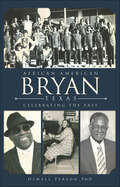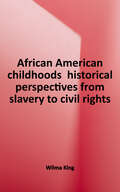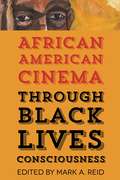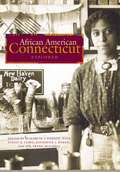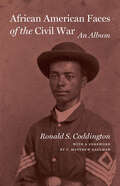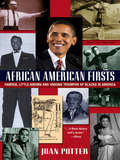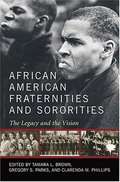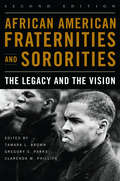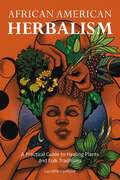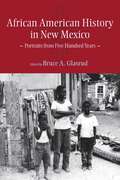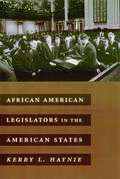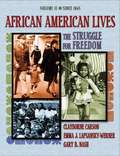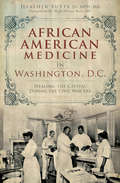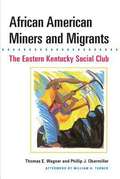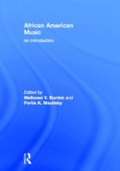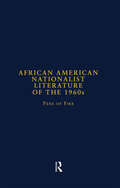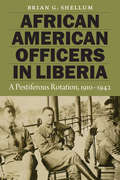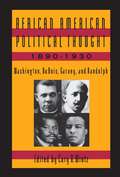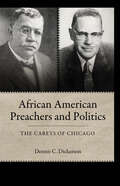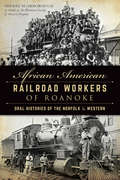- Table View
- List View
African American Bryan, Texas: Celebrating the Past (American Heritage)
by Oswell Person PhDBryan was incorporated in 1872, but it would take more than ten years before its African American population was offered schooling. Nothing would come easy for them, but they persevered through hard work, ingenuity and family support. The success of today's generation is a direct result of determined, hardworking pioneers like Dr. Samuel J. Sealey Sr., Bryan's "baby doctor" in the 1930s and '40s, and Dr. William A. Hammond Sr., who opened Bryan's first black hospital and employed many blacks through his business ventures. Learn about the inspiration and guidance provided by the likes of Oliver Wayne Sadberry, an outstanding community leader and principal of Fairview and Washington Elementary. Dr. Oswell Person shares the story of this community's achievements, successes and contributions in the face of incredible odds.
African American Childhoods: Historical Perspectives from Slavery to Civil Rights
by Wilma KingThis text seeks to fill a vacuum in the study of African American children. Recovering the voices or experiences of these children, we observe nuances in their lives based on their legal status, class standing, and social development.
African American Cinema through Black Lives Consciousness
by Mark A. Reid Gerald R. Butters Jr. Karen Bowdre African American Cinema Dan Flory African American Cinema Mark D Cunningham African American Cinema Patricia Hilliard-Nunn African American Cinema Kimberly Nichele Brown African American Cinema Chesya Burke African American Cinema Anne Cremieux African American Cinema James Smalls Charlene Regester Dr Jonathan Munby Dr Melba Joyce BoydAfrican American Cinema through Black Lives Consciousness uses critical race theory to discuss American films that embrace contemporary issues of race, sexuality, class, and gender. Its linear history chronicles black-oriented narrative film from post–World War II through the presidential administration of Barack Obama. Editor Mark A. Reid has assembled a stellar list of contributors who approach their film analyses as an intersectional practice that combines queer theory, feminism/womanism, and class analytical strategies alongside conventional film history and theory. Taken together, the essays invigorate a "Black Lives Consciousness," which speaks to the value of black bodies that might be traumatized and those bodies that are coming into being-ness through intersectional theoretical analysis and everyday activism. The volume includes essays such as Gerald R. Butters’s, "Blaxploitation Film," which charts the genre and its uses of violence, sex, and misogyny to provoke a realization of other philosophical and sociopolitical themes that concern intersectional praxis. Dan Flory’s "African-American Film Noir" explains the intertextual—fictional and socio-ecological—dynamics of black action films. Melba J. Boyd’s essay, "‘Who’s that Nigga on that Nag?’: Django Unchained and the Return of the Blaxploitation Hero," argues that the film provides cultural and historical insight, "signifies" on blackface stereotypes, and chastises Hollywood cinema’s misrepresentation of slavery. African American Cinema through Black Lives Consciousness embraces varied social experiences within a cinematic Black Lives Consciousness intersectionality. The interdisciplinary quality of the anthology makes it approachable to students and scholars of fields ranging from film to culture to African American studies alike.
African American Connecticut Explored
by Katherine J. Harris Olivia White Elizabeth J. Normen Stacey K. Close Wm. Frank MitchellThe numerous essays by many of the state's leading historians in African American Connecticut Explored document an array of subjects beginning from the earliest years of the state's colonization around 1630 and continuing well into the 20th century. The voice of Connecticut's African Americans rings clear through topics such as the Black Governors of Connecticut, nationally prominent black abolitionists like the reverends Amos Beman and James Pennington, the African American community's response to the Amistad trial, the letters of Joseph O. Cross of the 29th Regiment of Colored Volunteers in the Civil War, and the Civil Rights work of baseball great Jackie Robinson (a twenty-year resident of Stamford), to name a few. Insightful introductions to each section explore broader issues faced by the state's African American residents as they struggled for full rights as citizens. This book represents the collaborative effort of Connecticut Explored and the Amistad Center for Art & Culture, with support from the State Historic Preservation Office and Connecticut's Freedom Trail. It will be a valuable guide for anyone interested in this fascinating area of Connecticut's history.Contributors include Billie M. Anthony, Christopher Baker, Whitney Bayers, Barbara Beeching, Andra Chantim, Stacey K. Close, Jessica Colebrook, Christopher Collier, Hildegard Cummings, Barbara Donahue, Mary M. Donohue, Nancy Finlay, Jessica A. Gresko, Katherine J. Harris, Charles (Ben) Hawley, Peter Hinks, Graham Russell Gao Hodges, Eileen Hurst, Dawn Byron Hutchins, Carolyn B. Ivanoff, Joan Jacobs, Mark H. Jones, Joel Lang, Melonae' McLean, Wm. Frank Mitchell, Hilary Moss, Cora Murray, Elizabeth J. Normen, Elisabeth Petry, Cynthia Reik, Ann Y. Smith, John Wood Sweet, Charles A. Teale Sr., Barbara M. Tucker, Tamara Verrett, Liz Warner, David O. White, and Yohuru Williams.Ebook Edition Note: One illustration has been redacted.
African American Consciousness: Past and Present (Africana Studies)
by Jr. ConyersAfrican American Consciousness focuses on ideas of culture, race, and class within the interdisciplinary matrix of Africana Studies. Even more important, it uses a methodology that emphasizes interpretation and the necessity of interdisciplinary research and writing in a global society. Worldview, culture, analytic thinking, and historiography can all be used as tools of analysis, and in the process of discovery, use pedagogy, and survey research of Africana history. Advancing the idea of Africana Studies, mixed methodology, and triangulation, the contributors provide alternative approaches toward examining this phenomena, with regard to place, space, and time.The essays in this volume include Reynaldo Anderson, "Black History dot.com" Greg Carr, "Black Consciousness, Pan-Africanism and the African World History Project" Karanja Carroll, "A Genealogical Review of the Worldview Concept and Framework in Africana Studies" Denise Martin, "Reflections on African Celestial Culture" Serie McDougal "Teaching Black Males" Demetrius Pearson, "Cowboys of Color" Pamela Reed, "Heirs to Disparity" and Andrew Smallwood, "Malcolm X's Leadership and Legacy."The researchers in this volume investigate, explore, and review patterns of functional, normative, and expressive behavior. The past and present of Africana culture is represented, showing how reflexivity can be an adjustable concept to organize, process, and interpret data. Moreover, humanism and social science demonstrate how researchers establish, extract, and identify the limitations and alternative approaches to research of the historic conditions of black Americans.
African American Faces of the Civil War: An Album
by Ronald S. CoddingtonDiscover the men of color who fought for their freedom during the Civil War through profiles illustrated with original wartime photographs.A renowned collector of Civil War photographs and a prodigious researcher, Ronald S. Coddington combines compelling archival images with biographical stories that reveal the human side of the war. This third volume in his series on Civil War soldiers contains previously unpublished photographs of African American Civil War participants—many of whom fought to secure their freedom. During the Civil War, 200,000 African American men enlisted in the Union army or navy. Some of them were free men and some escaped from slavery; others were released by sympathetic owners to serve the war effort. African American Faces of the Civil War tells the story of the Civil War through the images of men of color who served in roles that ranged from servants and laborers to enlisted men and junior officers.Coddington discovers these portraits—cartes de visite, ambrotypes, and tintypes—in museums, archives, and private collections. He has pieced together each individual’s life and fate based upon personal documents, military records, and pension files. These stories tell of ordinary men who became fighters, of the prejudice they faced, and of the challenges they endured. African American Faces of the Civil War makes an important contribution to a comparatively understudied aspect of the war and provides a fascinating look into lives that helped shape America.
African American Faces of the Civil War: An Album
by Ronald S. CoddingtonDiscover the men of color who fought for their freedom during the Civil War through profiles illustrated with original wartime photographs.A renowned collector of Civil War photographs and a prodigious researcher, Ronald S. Coddington combines compelling archival images with biographical stories that reveal the human side of the war. This third volume in his series on Civil War soldiers contains previously unpublished photographs of African American Civil War participants?many of whom fought to secure their freedom.During the Civil War, 200,000African American men enlisted in the Union army or navy. Some of them were free men and some escaped from slavery; others were released by sympathetic owners to serve the war effort. African American Faces of the Civil War tells the story of the Civil War through the images of men of color who served in roles that ranged from servants and laborers to enlisted men and junior officers.Coddington discovers these portraits?cartes de visite, ambrotypes, and tintypes?in museums, archives, and private collections. He has pieced together each individual’s life and fate based upon personal documents, military records, and pension files. These stories tell of ordinary men who became fighters, of the prejudice they faced, and of the challenges they endured. African American Faces of the Civil War makes an important contribution to a comparatively understudied aspect of the war and provides a fascinating look into lives that helped shape America.“It does nothing to diminish the depth and precision of Coddington’s research to say that each compelling vignette prompts the reader to hurriedly flip to the next one.” —Publishers Weekly (starred review)
African American Firsts
by Joan PotterDid you know that. . . Ralph Bunche was the first African American to win the Nobel Peace Prize. Tony Dungy was the first African American NFL coach to win a Super Bowl game. Eric Holder became the first African American to serve as United States Attorney General. Ella Fitzgerald and Count Basie were the first African Americans to win Grammy awards. An African American doctor performed the first open-heart surgery. Excluded from history books, overlooked in classrooms, and neglected by media, African Americans have long been denied an accurate picture of their contributions to our nation, from colonial days to the present. But times have changed and the record will be set straight. From the inventor of the traffic light and the gas mask to winners of an Oscar and the Olympic gold, this authoritative resource reveals over 450 "firsts" by African Americans--wonderful accomplishments achieved often despite poverty, discrimination, and racism. Leaders in government, entertainment, education, science and medicine, the law, military, and in the business world, African Americans have made their mark. African American Firsts is a clear reflection of that prideful legacy, and a signpost to an even greater future. "African American Firsts works, works well, and works brilliantly. " --St. Louis Post-Dispatch "For browsing or serious queries on great achievements by blacks in America. " --Booklist "Fascinating. . . an excellent source for browsing and for locating facts that are hard to find elsewhere. " --School Library Journal "Reveals African American history as Potter had never been taught in predominantly white schools. " --Publishers Weekly "I recommend this book, a tool with innumerable possibilities which will help individuals understand. . . the contributions and inventions of African Americans. " --The late Dr. Betty Shabazz Over 75 Pages of Photographs Fully Revised and Updated Joan Potters nonfiction writing has appeared in numerous magazines and newspapers, including the New York Times, which published more than fifty of her articles. She is the co-author of two books: The Book of Adirondack Firsts, and the childrens book, African Americans Who Were First. Her personal essays appear in the anthologies Rooted in Rock, Living North Country, and Illness & Grace, Terror & Transformation, and in the Syracuse University literary journal, Stone Canoe. She has led writing workshops for Adirondack women and prison inmates, and has been teaching a memoir class since 1998 at the Hudson Valley Writers Center in Sleepy Hollow, New York.
African American Fraternities and Sororities: The Legacy and the Vision
by Clarenda M. Phillips Gregory S. Parks Tamara L. BrownAfrican American Fraternities and Sororities: The Legacy and the Vision explores the rich past and bright future of the nine black Greek-letter organizations that make up the National Pan-Hellenic Council. In the long tradition of African American benevolent and secret societies, intercollegiate African American fraternities and sororities have strong traditions of fostering brotherhood and sisterhood among their members, exerting considerable influence in the African American community, and being in the forefront of civic action, community service, and philanthropy.
African American Fraternities and Sororities: The Legacy and the Vision
by Clarenda M. Phillips Gregory S. Parks Tamara L. BrownThe rich history and social significance of the “Divine Nine” African American Greek-letter organizations is explored in this comprehensive anthology.In the long tradition of African American benevolent and secret societies, intercollegiate African American fraternities and sororities have strong traditions of fostering brotherhood and sisterhood among their members, exerting considerable influence in the African American community and being in the forefront of civic action, community service, and philanthropy. Dr. Martin Luther King, Jr., Toni Morrison, Arthur Ashe, and Sarah Vaughn are just a few of the trailblazing members of these organizations.African American Fraternities and Sororities places the history of these organizations in context, linking them to other movements and organizations that predated them and tying their history to the Civil Rights movement. It explores various cultural aspects of the organizations, such as auxiliary groups, branding, calls, and stepping, and highlights the unique role of African American sororities.
African American Herbalism: A Practical Guide to Healing Plants and Folk Traditions
by Lucretia VanDykeDiscover the roots of modern-day herbal remedies, plant medicine, holistic rituals, natural recipes, and more that were created by African American herbal healers throughout history.This first-of-its-kind herbal guide takes you through the origins of herbal practices rooted in African American tradition—from Ancient Egypt and the African tropics to the Caribbean and the United States. Inside you&’ll find the stories of herbal healers like Emma Dupree and Henrietta Jeffries, who made modern American herbalism what it is today. After rediscovering the forgotten legacies of these healers, African American Herbalism dives into the important contributions they made to the world of herbalism, including: Rituals for sacred bathing and skin care Herbal tinctures, potions, and medicine Recipes for healing meals and soul food And more! You&’ll also find a comprehensive herbal guide to the most commonly used herbs—such as aloe, lavender, sage, sassafras, and more—alongside gorgeous botanical illustrations. African American Herbalism is the perfect guide for anyone wanting to explore the medicinal and healing properties of herbs.
African American History in New Mexico: Portraits from Five Hundred Years
by Bruce A. GlasrudAlthough their total numbers in New Mexico were never large, blacks arrived with Spanish explorers and settlers and played active roles in the history of the territory and state. Here, Bruce Glasrud assembles the best information available on the themes, events, and personages of black New Mexico history.The contributors portray the blacks who accompanied Cabeza de Vaca, Coronado and de Vargas and recount their interactions with Native Americans in colonial New Mexico. Chapters on the territorial period examine black trappers and traders as well as review the issue of slavery in the territory and the blacks who accompanied Confederate troops and fought in the Union army during the Civil War in New Mexico. Eventually blacks worked on farms and ranches, in mines, and on railroads as well as in the military, seeking freedom and opportunity in New Mexico&’s wide open spaces. A number of black towns were established in rural areas. Lacking political power because they represented such a small percentage of New Mexico&’s population, blacks relied largely on their own resources and networks, particularly churches and schools.
African American History: Journey of Liberation (2nd Edition)
by Molefi K. AsanteThis book is a new history or historiography, a new way of writing about history. The author's task in writing this book was to capture the African agency, the action, and the excitement of this marvelous history.
African American Intellectual-Activists: Legacies in the Struggle (Studies in African American History and Culture)
by Dia N. SekayiThis study examines the narrated life experiences of 11 African American intellectual-activists. An intellectual-activist is defined as a person whose education has provided him or her with a body of knowledge to which he/she is continually adding (intellectual self) and who works daily for, or has a career dedicated to, the betterment of African American people (activist self). The voices of the subjects focus on the events in their lives that contributed to their development as intellectuals and activists. Discussions of the individuals' backgrounds illuminate the forces that influenced their life experiences and guided their actions toward involvement with the struggle to improve the lives of the African American community. The overarching theme in these life stories is the possession of a positive African American self-concept. The study explores the ways in which the subjects developed this positive self-concept, how this self-concept influenced the goals of their activism, and how they define progress toward these goals.
African American Legislators in the American States (Power, Conflict, and Democracy: American Politics Into the 21st Century)
by Kerry HaynieHas black inclusion in the political process changed political institutions and led to more black influence in the governmental process? How do African American legislators balance racial interests with broader issues of government? And how is their effectiveness subjectively perceived and objectively evaluated?In one of the first book-length studies to analyze the behavior of African American state legislators in multiple legislative sessions across five states, Kerry Haynie has compiled a wealth of valuable data that reveals the dynamics and effectiveness of black participation in the legislative process. Owing to the increasing role of state government in administering what he defines as key "black issues"— education, healthcare, poverty/social welfare, civil rights, and children's issues—Haynie focuses on bills introduced in these categories in Arkansas, Illinois, Maryland, New Jersey, and North Carolina.The book reveals how responsive political institutions have been to the nation's largest minority group. It explores the question of how legislators deal with the "duality dilemma"—which requires them to be both responsible legislators and race representatives—and whether agendas should be "deracialized" in order to appeal to a broader constituency. Along with numerous statistical charts illustrating everything from representation on house standing committees to a ranking of the fifteen legislative sessions by quartiles of African American political incorporation, a useful and revealing portrait emerges—one that will fuel debate and inform future discussions of the role of African Americans in the political process.
African American Lives: The Struggle for Freedom Volume II
by Gary B. Nash Clayborne Carson Emma J. Lapsansky-Werner'African American Lives, American History' uses a biographical approach to present African Americans as active and thoughtful agents in the construction of their lives and communities. Each chapter opens with a vignette focusing on an individual involved in a dramatic moment or event. Personal stories are told throughout the narrative.
African American Medicine in Washington, D.C.: Healing the Capital During the Civil War Era
by Heather ButtsThe true story of the black doctors and nurses who tended to Civil War soldiers in the capital. Just as African Americans fought in defense of the Union during the Civil War, African American nurses, doctors, and surgeons worked to heal those soldiers. In the nation&’s capital, these brave healthcare workers created a medical infrastructure for African Americans, by African Americans. Preeminent surgeon Alexander T. Augusta fought discrimination, visited President Lincoln, testified before Congress, and aided the war effort. Washington&’s Freedmen&’s Hospital was formed to serve the District&’s growing free African American population, eventually becoming the Howard University Medical Center. These physicians would form the National Medical Association, the largest and oldest organization representing African American doctors and patients. This book recounts the heroic lives and work of Washington&’s African American medical community during the Civil War.
African American Miners and Migrants: THE EASTERN KENTUCKY SOCIAL CLUB
by Thomas E. Wagner Philip J. ObermillerThomas E. Wagner and Phillip J. Obermiller's African American Miners and Migrants documents the lives of Eastern Kentucky Social Club (EKSC) members, a group of black Appalachians who left the eastern Kentucky coalfields and their coal company hometowns in Harlan County. Bound together by segregation, the inherent dangers of mining, and coal company paternalism, it might seem that black miners and mountaineers would be eager to forget their past. Instead, members of the EKSC have chosen to celebrate their Harlan County roots. African American Miners and Migrants uses historical and archival research and extensive personal interviews to explore their reasons and the ties that still bind them to eastern Kentucky. The book also examines life in the model coal towns of Benham and Lynch in the context of Progressive Era policies, the practice of welfare capitalism, and the contemporary national trend of building corporate towns and planned communities.
African American Music: An Introduction
by Mellonee Burnim Portia K. MaultsbyAfrican American Music: An Introduction is a collection of thirty essays by leading scholars which survey major African American musical genres, both sacred and secular, from slavery to the present. It is the most comprehensive study of African American music currently available, with sixteen essays on major genres of African American music, as well as lengthy sections on the music industry, gender, and music as resistance. The work brings together, in a single volume, treatments of African American music that have existed largely independent of each other. The research is based in large part on ethnographic fieldwork, which privileges the voices of the music-makers themselves, while interpreting their narratives through a richly textured mosaic of history and culture. The book is replete with references to seminal recordings and recording artists, musical transcriptions, photographs, and illustrations that bring the music to life as expressions of human beings.
African American Music: An Introduction
by Portia K. Maultsby Mellonee V. BurnimAmerican Music: An Introduction, Second Edition is a collection of seventeen essays surveying major African American musical genres, both sacred and secular, from slavery to the present. With contributions by leading scholars in the field, the work brings together analyses of African American music based on ethnographic fieldwork, which privileges the voices of the music-makers themselves, woven into a richly textured mosaic of history and culture. At the same time, it incorporates musical treatments that bring clarity to the structural, melodic, and rhythmic characteristics that both distinguish and unify African American music. The second edition has been substantially revised and updated, and includes new essays on African and African American musical continuities, African-derived instrument construction and performance practice, techno, and quartet traditions. Musical transcriptions, photographs, illustrations, and a new audio CD bring the music to life.
African American Nationalist Literature of the 1960s: Pens of Fire (Studies in American Popular History and Culture)
by Sandra Hollin FlowersBringing together political theory and literary works, this study recreates the political climate which made the 1960s an unforgettable era for young black Americans. A chapter on "The Many Shades of Black Nationalism," for instance, explains: why black nationalism is known by more than a dozen different names; how events in Africa influenced black nationalism in America; why Malcolm X's death had a greater impact on nationalism than did his life; and how the United States government unwittingly became nationalism's ally. Another chapter explores the bitter feud between the dominant factions of the 1960s-cultural and revolutionary nationalists. This feud erupted in both verbal and armed warfare and generated an abundance of political theory and literary works, much of which is out of circulation but is examined in the study. Nationalist poetry, theater, and fiction are each treated in separate chapters which exemplify the aesthetic and political concerns of this memorable period in American history and letters. Aside from its unique combination of artistic and political works, what makes this book important is the current revival of nationalist sentiment in African American life and arts. Though this revival is closely identified with the nationalism of the 1960s, it lacks the focus of that period. This study explains what gave the nationalism of the 1960s its focus, how that focus was expressed in art forms, and why 1960s nationalism continues to influence the African American identity and will probably do so well into the twenty-first century.
African American Officers in Liberia: A Pestiferous Rotation, 1910–1942
by Brian G. ShellumAfrican American Officers in Liberia tells the story of seventeen African American officers who trained, reorganized, and commanded the Liberian Frontier Force from 1910 to 1942. In this West African country founded by freed black American slaves, African American officers performed their duties as instruments of imperialism for a country that was, at best, ambivalent about having them serve under arms at home and abroad. The United States extended its newfound imperial reach and policy of “Dollar Diplomacy” to Liberia, a country it considered a U.S. protectorate. Brian G. Shellum explores U.S. foreign policy toward Liberia and the African American diaspora, while detailing the African American military experience in the first half of the twentieth century. Shellum brings to life the story of the African American officers who carried out a dangerous mission in Liberia for an American government that did not treat them as equal citizens in their homeland, and he provides recognition for their critical role in preserving the independence of Liberia.
African American Political Thought, 1890-1930: Washington, Du Bois, Garvey and Randolph
by Cary D. WintzThis text presents a selection of essays and speeches written between 1890 and 1930 by Booker T. Washington, W.E.B. Du Bois, A. Philip Randolph and Marcus Garvey. The work analyses African-American political thought, defining the options confronting African Americans in the 20th century.
African American Preachers and Politics: The Careys of Chicago (Margaret Walker Alexander Series in African American Studies)
by Dennis C. DickersonDuring most of the twentieth century, Archibald J. Carey, Sr. (1868–1931) and Archibald J. Carey, Jr. (1908–1981), father and son, exemplified a blend of ministry and politics that many African American religious leaders pursued. Their sacred and secular concerns merged in efforts to improve the spiritual and material well-being of their congregations. But as political alliances became necessary, both wrestled with moral consequences and varied outcomes. Both were ministers to Chicago's largest African Methodist Episcopal Church congregations—the senior Carey as a bishop, and the junior Carey as a pastor and an attorney. Bishop Carey associated himself mainly with Chicago mayor William Hale Thompson, a Republican, whom he presented to black voters as an ally. When the mayor appointed Carey to the city's civil service commission, Carey helped in the hiring and promotion of local blacks. But alleged impropriety for selling jobs marred the bishop's tenure. The junior Carey, also a Republican and an alderman, became head of the panel on anti-discrimination in employment for the Eisenhower administration. He aided innumerable black federal employees. Although an influential benefactor of CORE and SCLC, Carey associated with notorious FBI director J. Edgar Hoover and compromised support for Martin Luther King, Jr. Both Careys believed politics offered clergy the best opportunities to empower the black population. Their imperfect alliances and mixed results, however, proved the complexity of combining the realms of spirituality and politics.
African American Railroad Workers of Roanoke: Oral Histories of the Norfolk & Western (American Heritage)
by Historical Society of Western Virginia Sheree ScarboroughRoanoke, Virginia, is one of America's great historic railroad centers. The Norfolk & Western Railway Company, now the Norfolk Southern Corporation, has been in Roanoke for over a century. Since the company has employed many of the city's African Americans, the two histories are intertwined. The lives of Roanoke's black railroad workers span the generations from Jim Crow segregation to the civil rights era to today's diverse corporate workforce. Older generations toiled through labor-intensive jobs such as janitors and track laborers, paving the way for younger African Americans to become engineers, conductors and executives. Join author Sheree Scarborough as she interviews Roanoke's African American railroad workers and chronicles stories that are a powerful testament of personal adversity, struggle and triumph on the rail.
